Microsoft 70-413 Exam Practice Questions (P. 3)
- Full Access (337 questions)
- Six months of Premium Access
- Access to one million comments
- Seamless ChatGPT Integration
- Ability to download PDF files
- Anki Flashcard files for revision
- No Captcha & No AdSense
- Advanced Exam Configuration
Question #21
Your network contains an Active Directory forest named contoso.com.
You plan to automate the deployment of servers that run Windows Server 2012.
You identify the following requirements for the deployment:
✑ Update the custom images that will be used for the deployment.
✑ Add custom drivers to the images that will be used for the deployment.
✑ Add software packages to the images that will be used for the deployment.
✑ Perform a zero touch bare-metal installation that uses Wake On LAN.
A network consultant recommends using Windows Deployment Services (WDS) and the Windows Assessment and Deployment Kit (Windows ADK) to deploy the servers.
You need to identify which requirements are achieved by using the consultant's recommendations.
Which three requirements should you identify? Each correct answer presents part of the solution.
You plan to automate the deployment of servers that run Windows Server 2012.
You identify the following requirements for the deployment:
✑ Update the custom images that will be used for the deployment.
✑ Add custom drivers to the images that will be used for the deployment.
✑ Add software packages to the images that will be used for the deployment.
✑ Perform a zero touch bare-metal installation that uses Wake On LAN.
A network consultant recommends using Windows Deployment Services (WDS) and the Windows Assessment and Deployment Kit (Windows ADK) to deploy the servers.
You need to identify which requirements are achieved by using the consultant's recommendations.
Which three requirements should you identify? Each correct answer presents part of the solution.
- AUpdate the custom images used for the deployment.
- BAdd software packages to the images used for the deployment.
- CPerform a zero touch bare-metal installation that uses Wake On LAN.
- DAdd custom drivers to the images used for the deployment.
Correct Answer:
ABD
Microsoft Deployment Toolkit 2010
MDT 2010 requires Windows AIK for Windows.
Manage your images, from adding/removing drivers to easily swapping out the operating system you would like to deploy.
Reference:
https://sheska.com/windows-server-2012r2-automated-install-settings/ https://docs.microsoft.com/en-us/previous-versions/windows/it-pro/windows-server-2012-R2-and-2012/hh831764(v=ws.11)?redirectedfrom=MSDN#prerequisites- for-installing-windows-deployment-services
ABD
Microsoft Deployment Toolkit 2010
MDT 2010 requires Windows AIK for Windows.
Manage your images, from adding/removing drivers to easily swapping out the operating system you would like to deploy.
Reference:
https://sheska.com/windows-server-2012r2-automated-install-settings/ https://docs.microsoft.com/en-us/previous-versions/windows/it-pro/windows-server-2012-R2-and-2012/hh831764(v=ws.11)?redirectedfrom=MSDN#prerequisites- for-installing-windows-deployment-services
send
light_mode
delete
Question #22
Your company has a main office and four branch offices. The main office is located in London.
The network contains an Active Directory domain named contoso.com. The network is configured as shown in the exhibit. (Click the Exhibit tab.)
Each office contains several servers that run Windows Server 2012.
In each branch office, you plan to deploy an additional 20 servers that will run Windows Server 2012. Some of the servers will have a Server Core Installation of
Windows Server 2012.
You identify the following requirements for the deployment of the new servers:
✑ Operating system images must be administered centrally.
✑ The operating system images must be deployed by using PXE.
✑ The WAN traffic caused by the deployment of each operating system must be minimized.
You need to recommend a solution for the deployment of the new servers.
What should you recommend?
Exhibits -
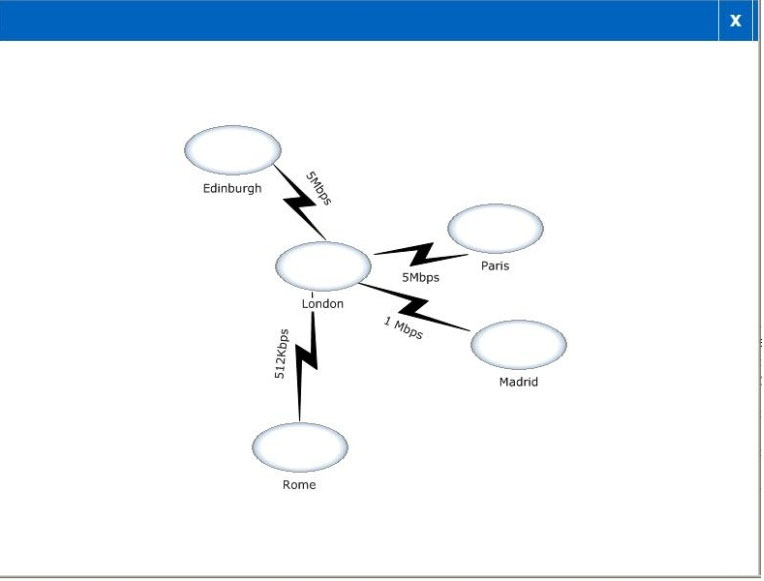
The network contains an Active Directory domain named contoso.com. The network is configured as shown in the exhibit. (Click the Exhibit tab.)
Each office contains several servers that run Windows Server 2012.
In each branch office, you plan to deploy an additional 20 servers that will run Windows Server 2012. Some of the servers will have a Server Core Installation of
Windows Server 2012.
You identify the following requirements for the deployment of the new servers:
✑ Operating system images must be administered centrally.
✑ The operating system images must be deployed by using PXE.
✑ The WAN traffic caused by the deployment of each operating system must be minimized.
You need to recommend a solution for the deployment of the new servers.
What should you recommend?
Exhibits -

- ADeploy Windows Deployment Services (WDS) in each office. Replicate the images by using Distributed File System (DFS) Replication,
- BDeploy Windows Deployment Services (WDS) in the main office only. Replicate the images by using Distributed File System (DFS) Replication.
- CDeploy Windows Deployment Services (WDS) in each office. Copy the images by using BranchCache.
- DDeploy Windows Deployment Services (WDS) in the main office only. Copy the images by using BranchCache.
Correct Answer:
A
DFS Replication is a replication engine that you can use to replicate images between Windows Deployment Services servers.
A
DFS Replication is a replication engine that you can use to replicate images between Windows Deployment Services servers.
send
light_mode
delete
Question #23
Your network contains an Active Directory forest named contoso.com. The forest is managed by using Microsoft System Center 2012.
Web developers must be able to use a self-service portal to request the deployment of virtual machines based on predefined templates. The requests must be approved by an administrator before the virtual machines are deployed.
You need to recommend a solution to deploy the virtual machines.
What should you include in the recommendation?
More than one answer choice may achieve the goal. Select the BEST answer.
Web developers must be able to use a self-service portal to request the deployment of virtual machines based on predefined templates. The requests must be approved by an administrator before the virtual machines are deployed.
You need to recommend a solution to deploy the virtual machines.
What should you include in the recommendation?
More than one answer choice may achieve the goal. Select the BEST answer.
- AA Virtual Machine Manager (VMM) service template, an Operations Manager dashboard, and an Orchestrator runbook
- BA Service Manager service offering, an Orchestrator runbook, and an Operations Manager dashboard
- CA Virtual Machine Manager (VMM) service template, a Service Manager service offering, and an Orchestrator runbook
- DA Service Manager service offering, an Orchestrator runbook, and Configuration Managerpackages
Correct Answer:
C
As a practical example, a user could initiate an Orchestrator runbook by requesting a service in a self-service portal. The runbook would then await approval by IT.
Once approved, it would then automatically provision the necessary virtual machines through System Center Virtual Machine Manager, deploy the required software via Configuration Manager, arrange backup through System Center Data Protection Manager and integrate monitoring with a third-party system.
C
As a practical example, a user could initiate an Orchestrator runbook by requesting a service in a self-service portal. The runbook would then await approval by IT.
Once approved, it would then automatically provision the necessary virtual machines through System Center Virtual Machine Manager, deploy the required software via Configuration Manager, arrange backup through System Center Data Protection Manager and integrate monitoring with a third-party system.
send
light_mode
delete
Question #24
DRAG DROP -
Your network contains an Active Directory domain named contoso.com. The domain contains a server named Server1 that runs Windows Server 2008 R2.
Server1 is a file server.
You deploy a new member server named Server2 that runs Windows Server 2012.
You plan to migrate file shares from Server1 to Server2. File share and NTFS permissions are assigned only to domain local groups.
You need to identify which actions are required to perform the migration.
Which five actions should you identify? To answer, move the appropriate actions from the list of actions to the answer area and arrange them in the correct order.
Select and Place:
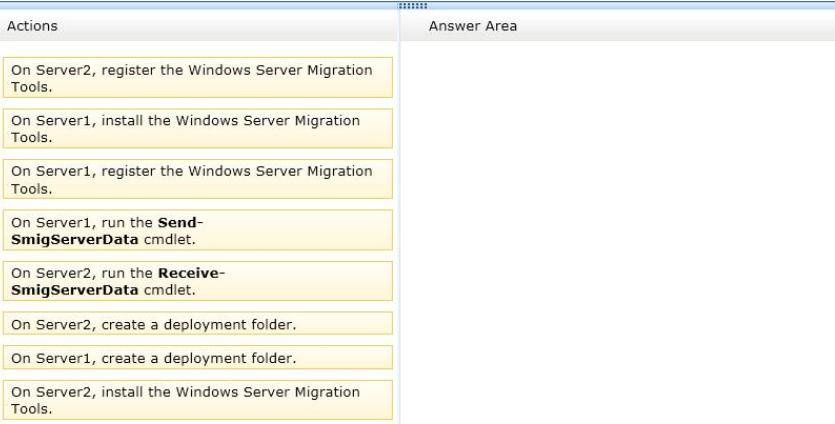
Your network contains an Active Directory domain named contoso.com. The domain contains a server named Server1 that runs Windows Server 2008 R2.
Server1 is a file server.
You deploy a new member server named Server2 that runs Windows Server 2012.
You plan to migrate file shares from Server1 to Server2. File share and NTFS permissions are assigned only to domain local groups.
You need to identify which actions are required to perform the migration.
Which five actions should you identify? To answer, move the appropriate actions from the list of actions to the answer area and arrange them in the correct order.
Select and Place:

Correct Answer:
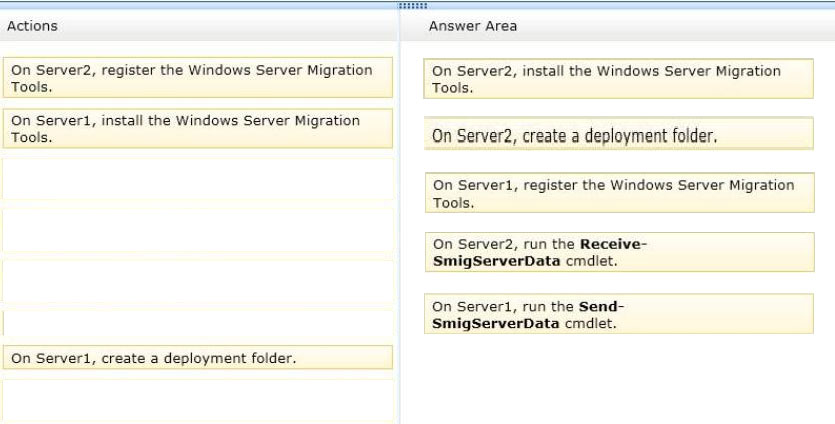
Note:
* Windows Server Migration Tools installation and preparation can be divided into the following stages.
✑ Installing Windows Server Migration Tools on destination servers that run Windows Server 2012.
✑ Creating deployment folders on destination servers that run Windows Server 2012, for copying to source servers.
✑ Copying deployment folders from destination servers to source servers.
✑ Registering Windows Server Migration Tools on source servers.
* Registering Windows Server Migration Tools on source computers
Before you can use a technology's Windows PowerShell snap-in for the first time, it must be registered with Windows PowerShell. You can use SmigDeploy.exe to register the Windows Server Migration Tools snap-in on a migration source computer
* Send-SmigServerData
This cmdletmigrates folders, files, and associated permissions and share properties from the local server to a target server. Send-SmigServerData must be run on the source server at the same time that the Receive-SmigServerDatacmdlet is running on the destination server.
* Receive-SmigServerData
This cmdlet allows a target server to receive shares, folders, files, and associated permissions and share properties that are migrated from a source server.
Receive-SmigServerData must be running on the destination server at the same time that the Send-SmigServerDatacmdlet is running on the source server.
* File server or data migration can be achieved by migrating the data from the existing server using tools such as Microsoft Robocopy and Microsoft File Server
Migration Tool (FSMT), or directly presenting the storage Logical Unit Number (LUNs) onto a new server.
* Windows Server Migration Tools is a feature that is available for installation on computers that are running Windows Server 2008 R2 by using the Add Features
Wizard in Server Manager. Windows Server Migration Tools can be removed from Windows Server 2008 R2 by using the Remove Features Wizard.
To migrate roles, features, and other data by using Windows Server Migration Tools, you must also deploy Windows Server Migration Tools on source servers from which you want to migrate data. Windows Server Migration Tools is deployed on source servers by creating a deployment folder on a computer that is running Windows Server 2008 R2, and then copying it to the pre-Windows Server 2008 R2 source computer operating systems shown in the table in this topic.

Note:
* Windows Server Migration Tools installation and preparation can be divided into the following stages.
✑ Installing Windows Server Migration Tools on destination servers that run Windows Server 2012.
✑ Creating deployment folders on destination servers that run Windows Server 2012, for copying to source servers.
✑ Copying deployment folders from destination servers to source servers.
✑ Registering Windows Server Migration Tools on source servers.
* Registering Windows Server Migration Tools on source computers
Before you can use a technology's Windows PowerShell snap-in for the first time, it must be registered with Windows PowerShell. You can use SmigDeploy.exe to register the Windows Server Migration Tools snap-in on a migration source computer
* Send-SmigServerData
This cmdletmigrates folders, files, and associated permissions and share properties from the local server to a target server. Send-SmigServerData must be run on the source server at the same time that the Receive-SmigServerDatacmdlet is running on the destination server.
* Receive-SmigServerData
This cmdlet allows a target server to receive shares, folders, files, and associated permissions and share properties that are migrated from a source server.
Receive-SmigServerData must be running on the destination server at the same time that the Send-SmigServerDatacmdlet is running on the source server.
* File server or data migration can be achieved by migrating the data from the existing server using tools such as Microsoft Robocopy and Microsoft File Server
Migration Tool (FSMT), or directly presenting the storage Logical Unit Number (LUNs) onto a new server.
* Windows Server Migration Tools is a feature that is available for installation on computers that are running Windows Server 2008 R2 by using the Add Features
Wizard in Server Manager. Windows Server Migration Tools can be removed from Windows Server 2008 R2 by using the Remove Features Wizard.
To migrate roles, features, and other data by using Windows Server Migration Tools, you must also deploy Windows Server Migration Tools on source servers from which you want to migrate data. Windows Server Migration Tools is deployed on source servers by creating a deployment folder on a computer that is running Windows Server 2008 R2, and then copying it to the pre-Windows Server 2008 R2 source computer operating systems shown in the table in this topic.
send
light_mode
delete
Question #25
DRAG DROP -
Your network contains an Active Directory domain named contoso.com. The domain contains a server named Server1 that runs Windows Server 2008. Server1 is configured as an enterprise certification authority (CA).
You back up all of the data on Server1, and then export the private and public keys of the CA.
You plan to replace Server1 with a new member server that was purchased recently.
You need to identify which actions must be performed on the new server to restore the certificate services of Server1.
Which three actions should you identify? To answer, move the appropriate actions from the list of actions to the answer area and arrange them in the correct order.
Select and Place:

Your network contains an Active Directory domain named contoso.com. The domain contains a server named Server1 that runs Windows Server 2008. Server1 is configured as an enterprise certification authority (CA).
You back up all of the data on Server1, and then export the private and public keys of the CA.
You plan to replace Server1 with a new member server that was purchased recently.
You need to identify which actions must be performed on the new server to restore the certificate services of Server1.
Which three actions should you identify? To answer, move the appropriate actions from the list of actions to the answer area and arrange them in the correct order.
Select and Place:

Correct Answer:

Box 1: You will need the Active Directory Certificate Services role to import the key, and later restore the certificate services database.
Box 2: Import the private key with the help of the AD CS Configuration Wizard. The private key will be needed in the next step when you restore the certificate services registry settings and the certificate services database.
Box 3: Restore the certificate services registry settings and the certificate services database

Box 1: You will need the Active Directory Certificate Services role to import the key, and later restore the certificate services database.
Box 2: Import the private key with the help of the AD CS Configuration Wizard. The private key will be needed in the next step when you restore the certificate services registry settings and the certificate services database.
Box 3: Restore the certificate services registry settings and the certificate services database
send
light_mode
delete
Question #26
Your network contains an Active Directory domain named contoso.com. The domain contains a Microsoft System Center 2012 infrastructure. The domain contains two sites named Site1 and Site2. The sites connect to each other by using a 1-Mbps WAN link.
The sites contain four servers. The servers are configured as shown in the following table.
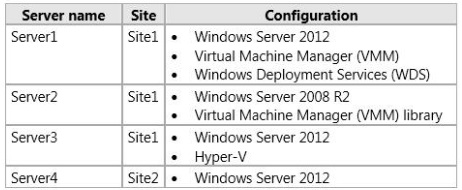
In Site2, you plan to deploy 50 Hyper-V hosts.
You need to recommend a solution to deploy the Hyper-V hosts by using VMM. The solution must minimize the amount of traffic between Site1 and Site2 during deployment.
What should you recommend?
The sites contain four servers. The servers are configured as shown in the following table.

In Site2, you plan to deploy 50 Hyper-V hosts.
You need to recommend a solution to deploy the Hyper-V hosts by using VMM. The solution must minimize the amount of traffic between Site1 and Site2 during deployment.
What should you recommend?
- AOn Server4, install VMM. From the Virtual Machine Manager console, add Server1 as a PXE server and add Server4 as a library server.
- BOn Server4/ install VMM. From the Virtual Machine Manager console, add Server1 as a PXE server and a library server.
- COn Server4, install WDS. From the Virtual Machine Manager console, add Server4 as a PXE server and a library server.
- DOn Server4, install WDS. From the Virtual Machine Manager console, add Server4 as a PXE server and add Server1 as a library server.
Correct Answer:
C
C
send
light_mode
delete
Question #27
Your network contains an Active Directory domain named contoso.com. The physical topology of the network is configured as shown in the exhibit.
Each office contains 500 employees.
You plan to deploy several domain controllers to each office.
You need to recommend a site topology for the planned deployment.
What should you include in the recommendation?
More than one answer choice may achieve the goal. Select the BEST answer.
Exhibit -
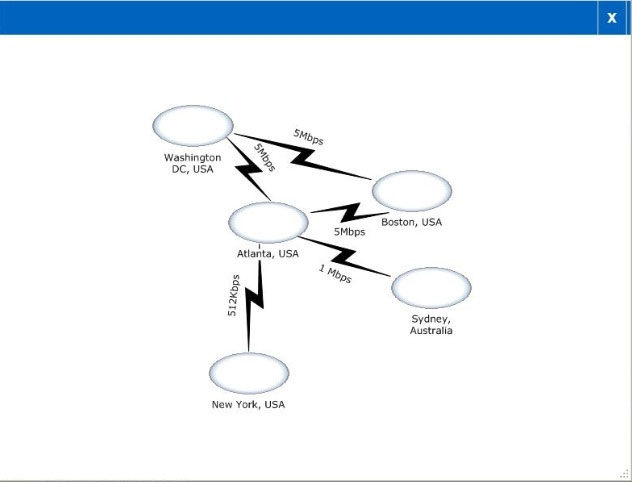
Each office contains 500 employees.
You plan to deploy several domain controllers to each office.
You need to recommend a site topology for the planned deployment.
What should you include in the recommendation?
More than one answer choice may achieve the goal. Select the BEST answer.
Exhibit -

- AFive sites and one site link
- BThree sites and three site links
- COne site
- DFive sites and three site links
Correct Answer:
D
Create a site for each LAN, or set of LANs, that are connected by a high-speed backbone, and assign the site a name. Connectivity within the site must be reliable and always available.
This would mean 5 sites Site links are transitive, so if site A is connected to site B, and site B is connected to site C, then the KCC assumes that domain controllers in site A can communicate with domain controllers in site C. You only need to create a site link between site A and site C if there is in fact a distinct network connection between those two sites.
This would mean 3 sitelinks -
So, answer is "Five sites and three site links"
Reference:
Defining Sites and Site Links -
http://technet.microsoft.com/en-us/library/cc960573.aspx
D
Create a site for each LAN, or set of LANs, that are connected by a high-speed backbone, and assign the site a name. Connectivity within the site must be reliable and always available.
This would mean 5 sites Site links are transitive, so if site A is connected to site B, and site B is connected to site C, then the KCC assumes that domain controllers in site A can communicate with domain controllers in site C. You only need to create a site link between site A and site C if there is in fact a distinct network connection between those two sites.
This would mean 3 sitelinks -
So, answer is "Five sites and three site links"
Reference:
Defining Sites and Site Links -
http://technet.microsoft.com/en-us/library/cc960573.aspx
send
light_mode
delete
Question #28
Your network contains an Active Directory forest. The forest contains a single domain. The forest has five Active Directory sites. Each site is associated to two subnets.
You add a site named Site6 that contains two domain controllers. Site6 is associated to one subnet.
You need to verify whether replication to the domain controllers in Site6 completes successfully.
Which two possible commands can you use to achieve the goal? Each correct answer presents a complete solution.
You add a site named Site6 that contains two domain controllers. Site6 is associated to one subnet.
You need to verify whether replication to the domain controllers in Site6 completes successfully.
Which two possible commands can you use to achieve the goal? Each correct answer presents a complete solution.
- AGet-ADReplicationSubnet
- BGet-ADReplicationUpToDatenessVectorTable
- Crepadmin /showattr
- DGet-ADReplicationSite1ink
- Erepadmin /showrepl
Correct Answer:
BE
B: The Get-ADReplicationUpToDatenessVectorTable cmdlet displays the highest Update Sequence Number (USN) for the specified domain controller(s). This information shows how up-to-date a replica is with its replication partners. During replication, each object that is replicated has USN and if the object is modified, the USN is incremented. The value of the USN for a given object is local to each domain controller where it has replicated are number is different on each domain controller.
E: The repadmin /showrepl command helps you understand the replication topology and replication failures. It reports status for each source domain controller from which the destination has an inbound connection object. The status report is categorized by directory partition.
BE
B: The Get-ADReplicationUpToDatenessVectorTable cmdlet displays the highest Update Sequence Number (USN) for the specified domain controller(s). This information shows how up-to-date a replica is with its replication partners. During replication, each object that is replicated has USN and if the object is modified, the USN is incremented. The value of the USN for a given object is local to each domain controller where it has replicated are number is different on each domain controller.
E: The repadmin /showrepl command helps you understand the replication topology and replication failures. It reports status for each source domain controller from which the destination has an inbound connection object. The status report is categorized by directory partition.
send
light_mode
delete
Question #29
Your company has a main office and four branch offices. The main office is located in London.
The network contains an Active Directory domain named contoso.com. Each office contains one domain controller that runs Windows Server 2012. The Active
Directory site topology is configured as shown in the exhibit. (Click the Exhibit tab.)
You discover that when a domain controller in a branch office is offline for maintenance, users in that branch office are authenticated by using the domain controllers in any of the sites.
You need to recommend changes to Active Directory to ensure that when a domain controller in a branch office is offline, the users in that branch office are authenticated by the domain controllers in London.
What should you include in the recommendation?
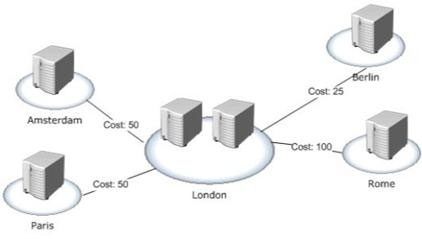
The network contains an Active Directory domain named contoso.com. Each office contains one domain controller that runs Windows Server 2012. The Active
Directory site topology is configured as shown in the exhibit. (Click the Exhibit tab.)
You discover that when a domain controller in a branch office is offline for maintenance, users in that branch office are authenticated by using the domain controllers in any of the sites.
You need to recommend changes to Active Directory to ensure that when a domain controller in a branch office is offline, the users in that branch office are authenticated by the domain controllers in London.
What should you include in the recommendation?

- AModify the DC Locator DNS Records settings.
- BDisable site link bridging.
- CModify the site link costs.
- DModify the service location (SRV) records in DNS.
Correct Answer:
A
If local DC (domain controller) is not available, DC Locator service will look for another DC in a different site.
Note: The following sequence describes how the Locator is able to find a domain controller (see step 3 below):
1. On the client (the computer locating the domain controller), the Locator is initiated as an RPC to the local Net Logon service. The Locator application programming interface (API) (DsGetDcName) is implemented by the Net Logon service.
2. The client collects the information that is needed to select a domain controller and passes the information to the Net Logon service by using the DsGetDcName
API.
3. The Net Logon service on the client uses the collected information to look up a domain controller for the specified domain in one of two ways: For a DNS name,
Net Logon queries DNS by using the IP/DNS-compatible Locator ג€" that is, DsGetDcName calls the DnsQuery API to read the Service Resource (SRV) records and A records from DNS, after it appends an appropriate string to the front of the domain name that specifies the SRV record.
Etc.
Reference:
Domain Controller Locator -
https://technet.microsoft.com/en-us/library/cc961830.aspx
A
If local DC (domain controller) is not available, DC Locator service will look for another DC in a different site.
Note: The following sequence describes how the Locator is able to find a domain controller (see step 3 below):
1. On the client (the computer locating the domain controller), the Locator is initiated as an RPC to the local Net Logon service. The Locator application programming interface (API) (DsGetDcName) is implemented by the Net Logon service.
2. The client collects the information that is needed to select a domain controller and passes the information to the Net Logon service by using the DsGetDcName
API.
3. The Net Logon service on the client uses the collected information to look up a domain controller for the specified domain in one of two ways: For a DNS name,
Net Logon queries DNS by using the IP/DNS-compatible Locator ג€" that is, DsGetDcName calls the DnsQuery API to read the Service Resource (SRV) records and A records from DNS, after it appends an appropriate string to the front of the domain name that specifies the SRV record.
Etc.
Reference:
Domain Controller Locator -
https://technet.microsoft.com/en-us/library/cc961830.aspx
send
light_mode
delete
Question #30
Your network contains an Active Directory domain named contoso.com. All servers run Windows Server 2008 R2. All domain controllers are installed on physical servers. The network contains several Hyper-V hosts.
The network contains a Microsoft System Center 2012 infrastructure.
You plan to use domain controller cloning to deploy several domain controllers that will run Windows Server 2012.
You need to recommend which changes must be made to the network infrastructure before you can use domain controller cloning.
What should you recommend?
The network contains a Microsoft System Center 2012 infrastructure.
You plan to use domain controller cloning to deploy several domain controllers that will run Windows Server 2012.
You need to recommend which changes must be made to the network infrastructure before you can use domain controller cloning.
What should you recommend?
- AUpgrade a global catalog server to Windows Server 2012. Deploy Virtual Machine Manager (VMM).
- BUpgrade a global catalog server to Windows Server 2012. Install the Windows Deployment Services server role on a server that runs Windows Server 2012.
- CUpgrade the domain controller that has the PDC emulator operations master role to Windows Server 2012. Deploy a Hyper-V host that runs Windows Server 2012.
- DUpgrade the domain controller that has the infrastructure master operations master role to Windows Server 2012. Install the Windows Deployment Services server role on a server that runs Windows Server 2012.
Correct Answer:
C
The clone domain controller uses the security context of the source domain controller (the domain controller whose copy it represents) to contact the Windows
Server 2012 Primary Domain Controller (PDC) emulator operations master role holder (also known as flexible single master operations, or FSMO). The PDC emulator must be running Windows Server 2012, but it does not have to be running on a hypervisor.
The requirements for domain controller cloning are:
The hypervisor must support VM-GenerationID. Hyper-V running on Windows Server 2012 supports this feature. Other virtualization vendors will have the ability to implement this as well, so check with your vendor to see if it's supported.
The source virtual DC must be running Windows Server 2012.
The PDC emulator role holder must be online and available to the cloned DC and must be running Windows Server 2012.
Reference:
Virtual Domain Controller Cloning in Windows Server 2012
https://blogs.technet.microsoft.com/askpfeplat/2012/10/01/virtual-domain-controller-cloning-in- windows-server-2012/
C
The clone domain controller uses the security context of the source domain controller (the domain controller whose copy it represents) to contact the Windows
Server 2012 Primary Domain Controller (PDC) emulator operations master role holder (also known as flexible single master operations, or FSMO). The PDC emulator must be running Windows Server 2012, but it does not have to be running on a hypervisor.
The requirements for domain controller cloning are:
The hypervisor must support VM-GenerationID. Hyper-V running on Windows Server 2012 supports this feature. Other virtualization vendors will have the ability to implement this as well, so check with your vendor to see if it's supported.
The source virtual DC must be running Windows Server 2012.
The PDC emulator role holder must be online and available to the cloned DC and must be running Windows Server 2012.
Reference:
Virtual Domain Controller Cloning in Windows Server 2012
https://blogs.technet.microsoft.com/askpfeplat/2012/10/01/virtual-domain-controller-cloning-in- windows-server-2012/
send
light_mode
delete
All Pages
